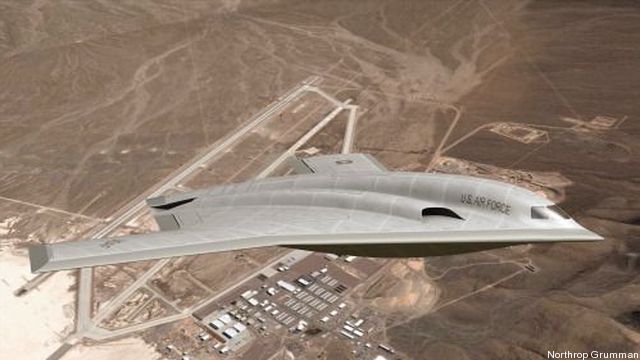
An artist’s concept for a stealthy future Long-Range Strike Bomber.
EGLIN AIR FORCE BASE, FLORIDA: Even as Defense Secretary Chuck Hagel flew here with much fanfare to reaffirm his “strong, strong confidence” in the troubled F-35 Joint Strike Fighter, the Air Force quietly let slip they have started a competition for the Long-Range Strike Bomber. The two programs could hardly be more different. JSF is the military’s massive investment – its over-investment, critics argue – in replacing its aging fleet of short-ranged but flexible fighters. LRS-B involves a much smaller number of much larger planes with the bomb load, range, and stealth to revive the long-neglected long-range bomber force.
This summer was supposed to be the F-35’s high-profile international debut. But with the fleet grounded by a recent engine fire, the stealth fighter is certain to miss what was to have been its first foreign appearance, at tomorrow’s Royal International Air Tattoo (RIAT) in Britain. Reporters here peppered Sec. Hagel with questions whether the F-35 would make it to the subsequent airshow at Farnborough. Hagel resolutely refused to answer, saying safety was the overriding priority and he’d leave decisions on the aircraft’s return to flight to “the experts” and their ongoing investigations.
By contrast, the Long-Range Strike Bomber is evolving deep in secrecy. In fact, now that the Air Force has launched a competition with yesterday’s formal Request For Proposals (even the due date for proposals is secret), it’s promised to say even less. That’s impressive considering (as my colleague Colin Clark pointed out recently) that the Air Force has released almost no new information about the LRS-B since 2012. The Long-Range Strike Bomber is supposed to be stealthy, like the current batwinged B-2, but faster and significantly cheaper, at $550 million per system. We have to say “system” instead of “plane” because the LRS-B may actually be a collective of several aircraft, manned and unmanned, networked together into a single tactical unit.
Congressional Research Service analyst Jeremiah Gertler looked at planned funding trendlines in a recent report and inferred the Air Force must have already done most of the development work on the bomber already, even building prototypes, in the classified “black” budget. If true, that could make the yesterday’s RFP largely a formality rather than a real competition. But we simply don’t know.
Navy jet trainer fleet operations remain paused after engine mishap
One week after the incident, a Navy spokesperson says the service is continuing to assess the fleet’s ability to safely resume flight.


























